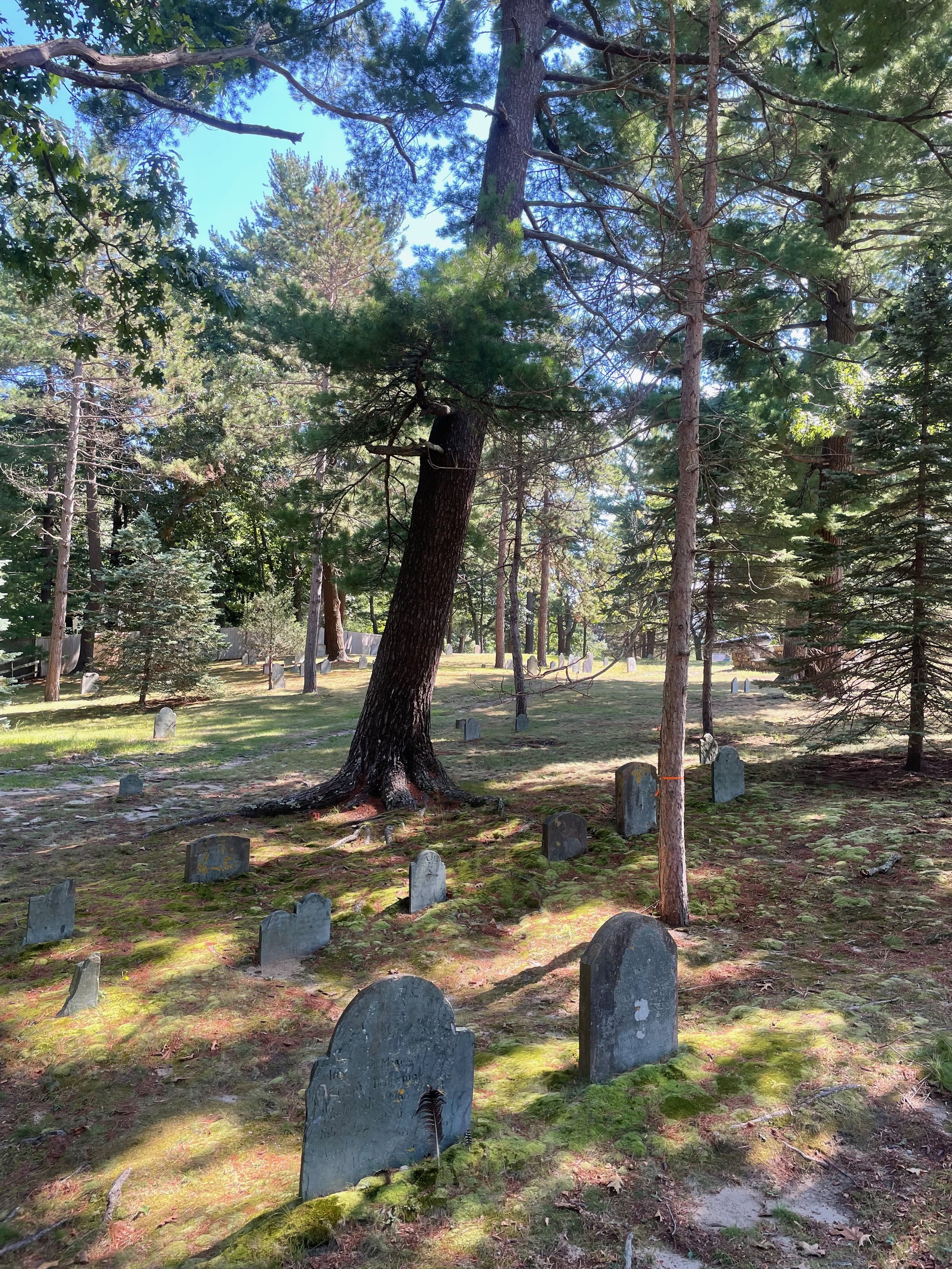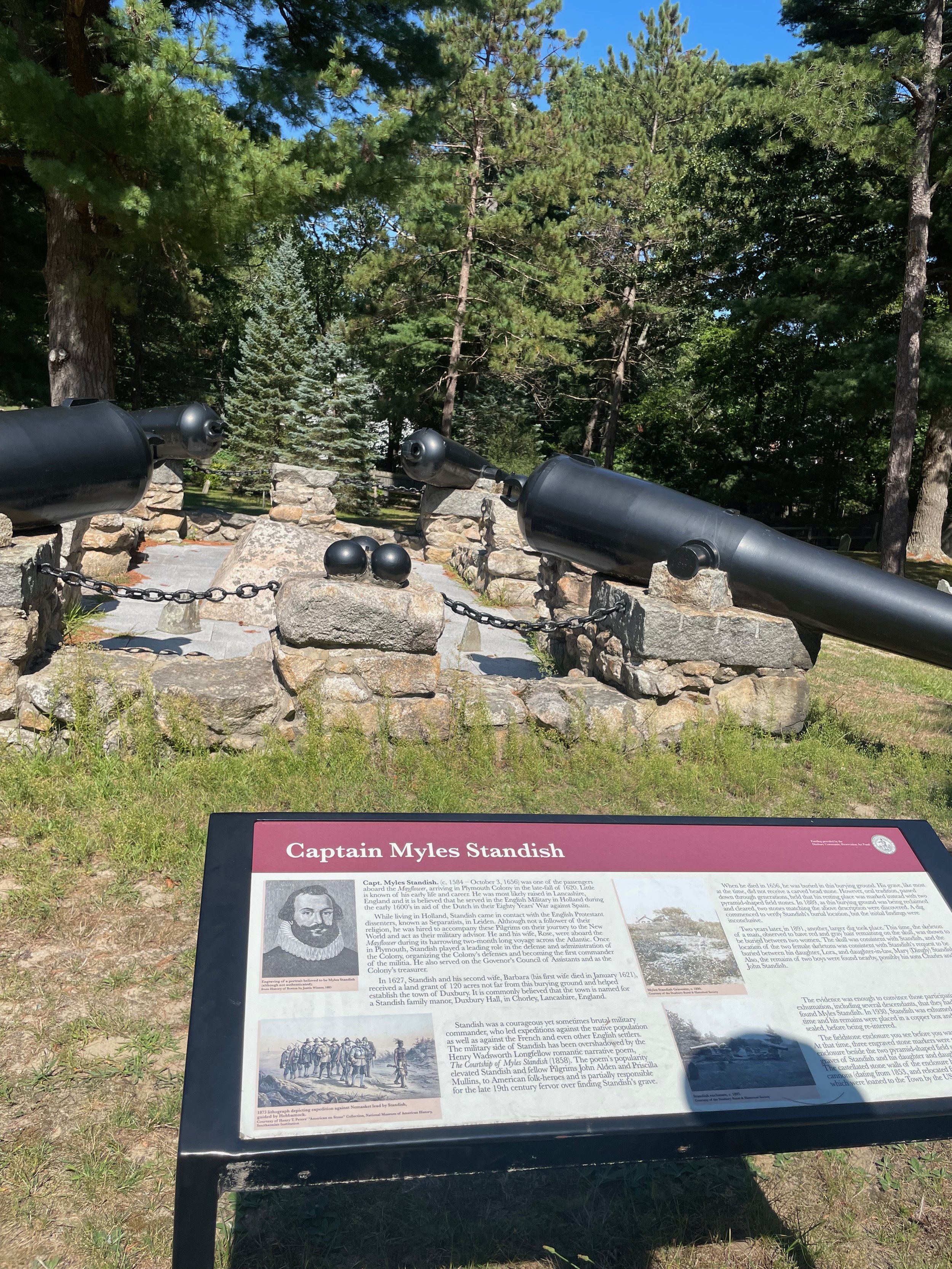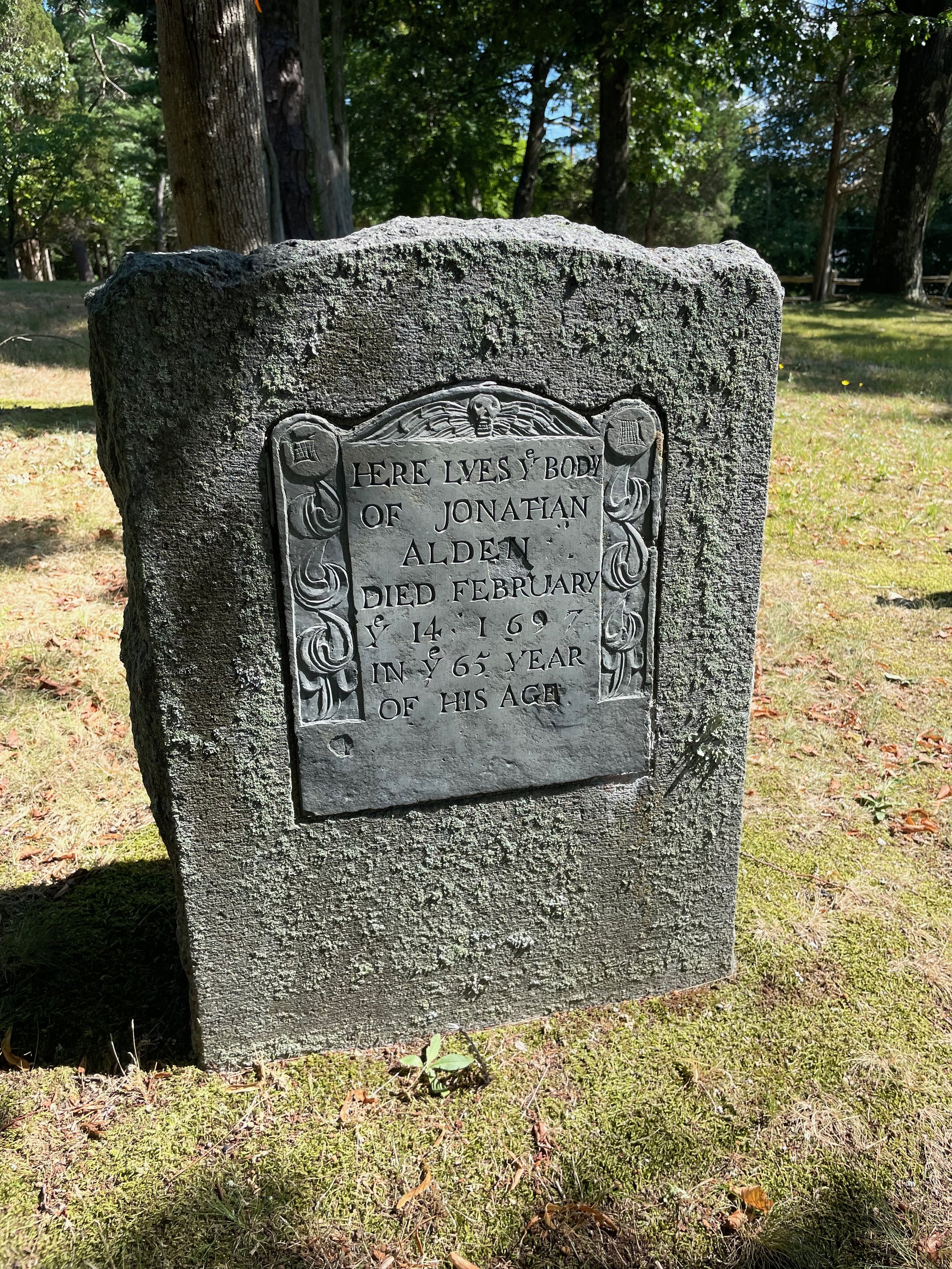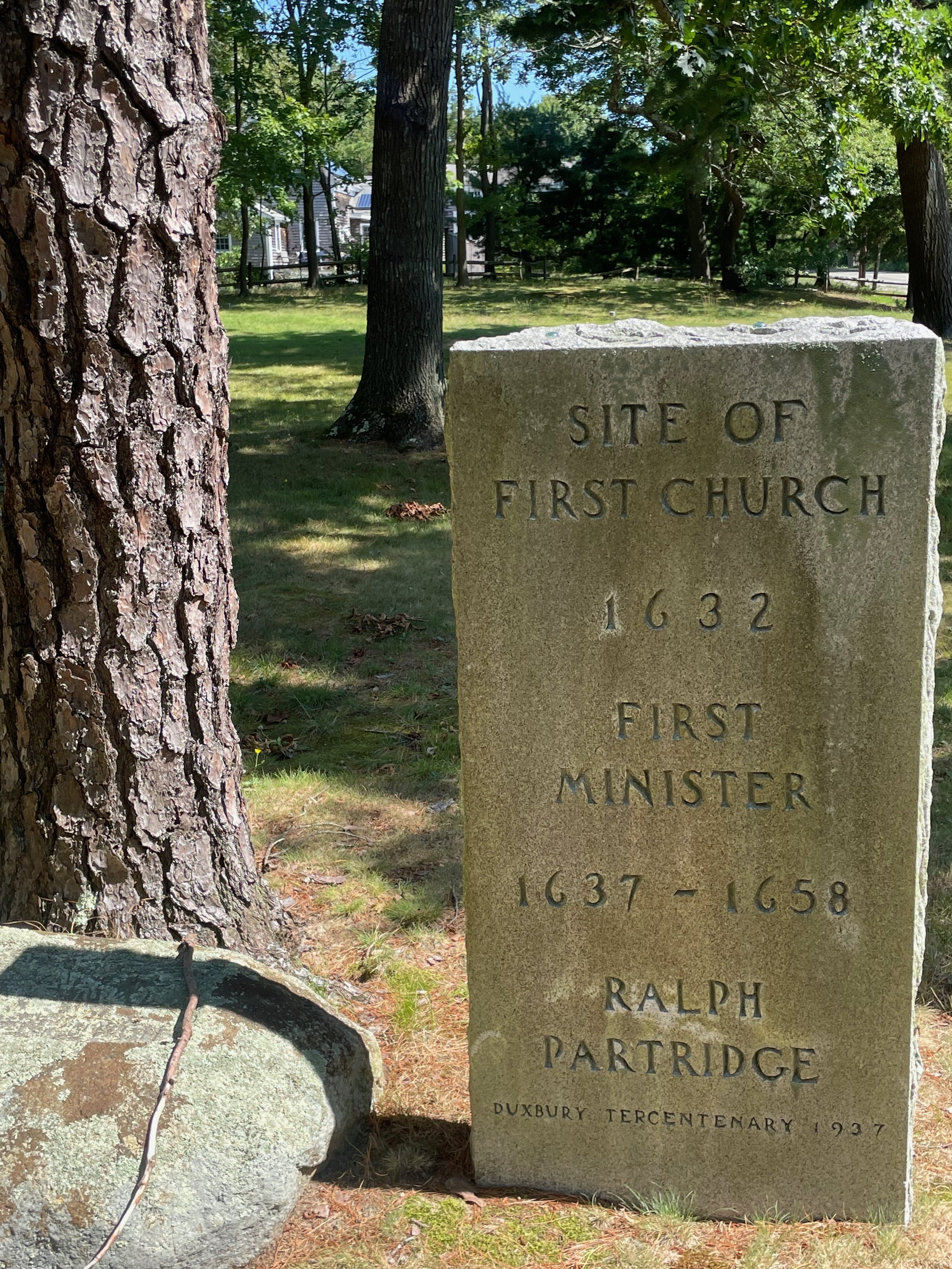Myles Standish Burial Ground
Old Burial Ground
Location: Duxbury, Ma, United States
A cornerstone of the very beginning of American history is the Mayflower. The journey and the fervent establishment of a new settlement was the very start. The Pilgrams sought America as their new “promise land” for expression of religious freedom and to free themselves of religious persecution from the British. The first problem upon landfall the Pilgrams had was they did not land in the correct place. The area of America expected to be colonized was farther south. Miss landing led to further issues between passengers as well, being that not all were in fact Pilgrims. Those who were not Pilgrims referred to as “strangers” felt due to miss landing they were no longer obligated to their signed contracts. This created the need for the Mayflower Compact. It bound all passengers onboard to obey and recognize a legal system established in Plymouth Colony. After the signing they set forth to colonize the newfound world. The America we know today is a beautiful land of fertile farms with copious resources to which we can live comfortably. In the 1600’s this new “promise land” was far from it. Arriving in November of 1620, to the beginning of a bitter New England winter to come, poised a disastrous outcome in the months ahead. They were unable to plant any resources of food leading to starvation, build adequate shelter and were improperly dressed for the weather conditions. Half of the Pilgrams who journeyed across the Atlantic would find their end before it even began in the new world. The expedition on land to find a suitable settlement was even more perilous and led to deaths. Those lost first unfortunately did not have lasting burial sites or maintained graves. They are remembered by a memorial gravestone within Coles Hill Burial Ground in Plymouth where most are believed to be buried in mass unmarked graves. Passengers were stuck onboard the Mayflower until the spring of April 1621. This led to the spread of pneumonia, tuberculosis, and scurvy for those hiding aboard in place of shelter. 53 out of 102 passengers were the only survivors (only one death was at sea) of their very first winter in the new world.
Buried inside Myles Standish Burial Ground are residents of the group who did survive and start life anew in the promised land and some of their decedents. This is the oldest maintained cemetery in the United States. Around 130 headstones have been accounted for, but the number of buried souls is unknown. The grounds were first used as a meeting house/church in 1632 and a burial ground starting in 1634 till 1789. The exact dates of the grounds being used as a cemetery vary due to the erosion of headstone dates. It was then abandoned till 1887 when the Duxbury Rural Society took over the grounds and rediscovered Myles Standish’s grave. A cemetery almost lost from history, neglected until perchance gave it and the residents inside the recognition they deserve in history.
Before movies, books and poetry often created public fascinations with periods of history. Much like today the public’s curiosity of one-story led to others or the insatiable need to know more about the character’s true history. The Courtship of Myles Standish was one of the sparks that restarted the public’s obsession with early colonial America. Published in 1858 by American poet Henry Wadsworth Longfellow, the poem was about a historical love triangle set in the early years of the Plymouth colony. Settlers Capt. Myles Standish and John Alden vie for the affections of the beautiful Priscilla Mullins. Longfellow further intrigued the public with the claims that the poem was based off a true story passed down from oral history within his family. He was a descendant of Priscilla Mullins himself, which strengthened his poem’s authenticity. His claims have so far been inconclusive, yet the characters are very real, and the story has many nonfiction aspects taken or recounted from history.
Capt. Myles Standish, to many New Englanders familiar with Massachusetts, is a well-known name from roads, monuments, cities, industrial parks, and state parks being named after him. He was an English military officer who was hired to assist the Pilgrams in military defense and start an administration. Standish was elected as the first commander in the Plymouth militia and was reelected for the rest of his life going forward. He led raids against the natives, was assistant governor of the colony from time to time, traveled back to England as a colony representative and served as its treasurer. Many recognized him as a great military leader but were deeply troubled with the brutality he unleashed on the Native’s finding it unnecessary. The popularity of the poem depicts Standish as a timid romantic (spoiler alert: no, he did not win Priscilla over). This had many fans forget his brutal actions against the Native’s. In the end he retired to Duxbury, MA, becoming one the first settlers in the area and took up farming. He still assisted the Pilgrams in an advisory capacity in the administration yet more interestingly never joined their church (or no evidence suggests so). He was a vital person in the establishment of America. Yet when Longfellow published his poem. The Old Burial Ground of Standish’s and other Mayflower passengers’ final resting place was dilapidated, overgrown and used by livestock to graze. The public’s interest in the poem led to the rediscovery of the cemetery and its need to be restored around 1878. It was a heartwarming moment where popularity of a poem led to the restoration of American Pilgrams resting places. Finding the character’s final resting places became vital intrigue to the public. Standish’s body was exhumed a total of 3 times in process of restoration and finally on the 3rd time sealed in a copper casket in 1930. Beneath the burial chamber within his grave is a time capsule left for years to come leading to the question will he again be exhumed? He and his family are buried beneath a stone slab and a large triangle grave marker with short stone walls surrounded by cannons. A tribute to the first military commander of the Plymouth Militia, the cemetery was renamed Myles Standish Burial Ground.
The graves of John Alden, and Priscilla Mullins were also discovered in the cemetery from the poem and other known passengers of the Mayflower. John Alden was the Mayflowers cooper (a shipmate responsible for the ships barrels) who decided to settle in the new world. He served on the Governor’s Council, was the colony's treasurer for a turn and a member of the war council. Priscilla Mullin was the famous beautiful woman whom the men are supposed to have competed for. She also was a passenger on the Mayflower, who’s family tragically died in the first winter. Her father, brother and stepmother all passed away. Left orphaned in a new world, she then married John Alden, noted to be the third couple married in the colony records. Alden’s headstone marks his grave, but Priscilla’s gravesite is unknown. Next to his, is a headstone to commemorate her memory placed during the restoration of the cemetery.
The graves of other passengers surround the burial site noted as passengers and/or signees of the Mayflower Compact. Their brave journey to a faraway unknown land, the lives they built, and the families created regardless of the dangers they faced are briefly remembered by visitors. Revolutionary soldiers are rumored to be buried but their graves are unmarked or lost from age. Visitors notice one very key attribute to this cemetery that might take a moment to realize is how bare and large it looks. Many of the graves do not have tall, large headstones. The expansive 1.44 acres of land the burial ground is on feels open and sparsely used at first glance. Old cemeteries were known to be crowded or having graves appear near or on top of each other. The unusual feeling of space is an oddly chilling impression of 400 years passing by with the residents' lives in historical significance almost lost to time. Eroded headstones now replaced by stone markers make up plenty of the resident's headstones. This cemetery is also the first to have a funeral sermon. In 1697 Pastor Ichabod Wiswall officiated the burial of Capt. John Alden. John and Priscilla’s son. In the past burials took place in silence in the new world. Resources were scarce and skilled stone workers even scarcer. Yet the Pilgrams also had a reason for not marking their graves, no mourning period and no eulogy taking place. They did not want the Native Americans to know about their losses. Scared of their disadvantage in numbers they took these precautions until the settlement was established. We then see in history more elaborate burials and memorials take place. The first meeting house is remembered by square stones set for each corner as a marker to define where it once stood, helping to create the foundations of America. The lack of replication is more impressionable than if it was recreated and standing before you. Hauntings are not widely known in the Standish Burial Grounds. The lack of fame and being forgotten over the years have blessed this cemetery with the ability to go untraveled by many and souls left unbothered but remembered forever written in history.
Further Reading:
https://www.town.duxbury.ma.us/cemetery-crematory/pages/old-burying-ground
https://seeplymouth.com/listing/myles-standish-burial-ground/
https://plimoth.org/for-students/homework-help/mayflower-and-mayflower-compact#:~:text=The%201620%20agreement%20(first%20called,they%20arrived%20in%20New%20England.





